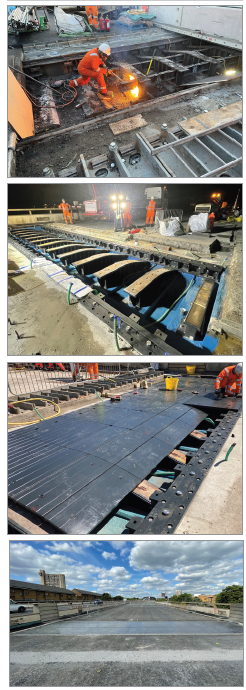Client: TfL
Designer: Freyssinet Products Company (FPC)
Principal Contractor: Costain
Works Commenced: November 2021
Works Completed: June 2022
The A40 Westway Structures Refurbishment project is one of the Major Asset Renewal Programme (formally STIP2) projects, covering Westway Structures which carry the elevated A40 dual carriageway from Wood Lane Flyover to the west side of Marylebone Flyover and Marylebone Flyover itself. The overall length of the site covered by the project is 4.5km, passing through the London Boroughs of Kensington and Chelsea, Hammersmith and Fulham and the City of Westminster.
Phase 1 of the A40 refurbishment included the concept design for the removal/replacement of the existing roller shutter joint and the temporary works design to carry out the work in phases allowing traffic to pass through. The detailed joint design following after the AIP Approval was particularly significant as it needed to accommodate the 1m movement of the structure.
The works were split up into two segments for mid-week working, which involved closures on the hard shoulder and lane one for phase one, closures on lane two and three for phase two and the overlapping areas between the two phases known as the dead zone, completed at the weekend.
The makeup of the joint consisted of top plates, which were the running surface of the joint and runner beams on which the top plates slide along. Edge beams were used for the support of the top plates.
The key activities for Freyssinet included hydro demolition to free the existing joint from the structure, followed by precision coring 72no. 110mm cores across the carriageway to allow for the anchors of the roller shutter joint to be installed. The beams and support plates were then embedded in either concrete or grout depending on the location, which was proved challenging when manoeuvring concrete
wagons in tight and restrictive lane closures.
During the final full closures and once the whole substructure was in place, the top plates were installed across the entire carriageway, ensuring that a smooth-running surface across the joint was achieved followed by the sub surface drainage and noising. This highlighted the importance of the initial setting out of the first beam, as installation of subsequent beams were dictated by it and there
was no margin for error.
Collaboration was key during weekend working shifts, as a number of stakeholders were required to work in and around the full weekend road closures. Collaborative planning and communication ensured the weekend sessions were executed successfully.
The works required multiple lifting activities, with several restrictions including live traffic running parallel to the works, London Underground within eight metres of the work site and a narrow working environment. The Freyssinet team developed clear methodologies and carefully planned each lift. As a result all lifts were carried out successfully and the team received praise from Costain for their management and execution.
Find out more about Freyssinet expansion joints here.

